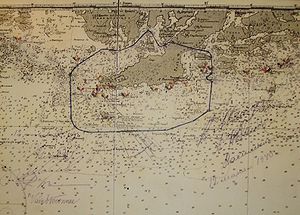Battle of Hanko (1941)
| Battle of Hanko | |||||||
|---|---|---|---|---|---|---|---|
| Part of the Continuation War and Eastern Front | |||||||
 Map showing the borders of the leased area |
|||||||
|
|||||||
| Belligerents | |||||||
|
|
|
||||||
| Strength | |||||||
| 22,000 (July 1941) 12,500 (Autumn 1941) |
25,300 to 30,000 | ||||||
| Casualties and losses | |||||||
|
Total: 961 Killed: 297 Wounded: 604 Missing: 78 |
n/a | ||||||
The Battle of Hanko (also known as the Hanko Front or the Siege of Hanko) was a lengthy series of small battles fought on Hanko Peninsula during the Continuation War between Finland and the Soviet Union in the second half of 1941. As both sides were eager to avoid a major, costly ground battle, fighting took the form of trench warfare, with artillery exchanges, sniping, patrol clashes, and small amphibious operations performed in the surrounding archipelago. A volunteer Swedish battalion served with Finnish forces in the siege. The last Soviet troops left the peninsula in December 1941.
As part of the 1940 Moscow Peace Treaty which formally ended the Soviet-Finnish Winter War, Hanko was leased to the Soviet Union as a Soviet Naval Base. The civilian population was forced to evacuate before Soviet forces arrived. The leased area included several surrounding islands, several coastal artillery sites (among them the important fort of Russarö), important harbor facilities, and an area suitable for an airfield, which the Soviets quickly constructed. Troop transport rights from the Soviet Union to Hanko and back put severe strain on Finnish-Soviet relations, and played a part both in Finland's decision to allow German troops to transit Northern Finland, and later, to go to war with the Soviet Union. Though Hanko had originally been leased as a naval base, ground forces were far more numerous, with only a small naval detachment being present at the base.
At the start of the war, Finnish ground troops quickly isolated Hanko and its 25,300-man Soviet garrison. Though Mannerheim initially declared that liberating Hanko would be a primary goal of the war, Finnish troops in the area did not receive authorization to attack the base. Instead, as the Finns had built the Harparskog line on the border of the leased area during the Interim Peace, they moved to occupy these positions. The front remained mostly static, with action consisting mainly of artillery strikes and some limited probing or patrol activities on both sides. Small scale naval and amphibious actions took place in the surrounding archipelago. Finnish forces surrounding the base initially consisted of the 17th Division, the 4th Coastal Brigade, and supporting units. By the end of the summer, the 17th Division, which had made up the bulk of the besieging force, was transferred to East Karelia.
...
Wikipedia
